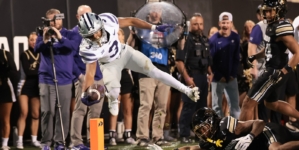-
How to Watch Kentucky vs Louisville: Live Stream NCAA College Football, TV Channel - 18 mins ago
-
Latin American Leaders Face Both Trump and Voters Deported by the U.S. - 26 mins ago
-
How to Watch Colorado vs Kansas State: Live Stream College Football, TV Channel - 53 mins ago
-
Trump Declares Venezuelan Airspace Closed - about 1 hour ago
-
Urban Meyer Publicly Trolls Michigan Fans Ahead of Rivalry Game vs. Ohio State - about 1 hour ago
-
Did Pope Leo Pray in Istanbul’s Blue Mosque? Not Visibly, at Least. - 2 hours ago
-
How to Watch Barcelona vs Alavés: Live Stream La Liga, TV Channel - 2 hours ago
-
Unexpected Coach Surging for Penn State Job Amid Kalen DeBoer Rumor - 3 hours ago
-
How I Began to Love Reading Again - 3 hours ago
-
School enrollment plummets in LAUSD and beyond amid immigration raids - 3 hours ago
Parasitic Wasp That Caught Prey in ‘Venus Flytrap’ Body Discovered in Amber
Paleontologists have discovered a disturbing new species of ancient wasp that restrained its prey using its Venus flytrap-like abdomen before laying eggs in the victim.
The parasite, named Sirenobethylus charybdis after the seawater-swallowing monster from Greek mythology, may represent a whole new family of insects.
S. charybdis lived 98.79 million years ago, during the mid-Cretaceous period, in what is today Myanmar, according to the international research team from China and Denmark.
“The rounded abdominal apparatus, combined with the setae [bristles] along the edges, is reminiscent of a Venus flytrap,” the researchers said in their paper.
“Nothing similar is known from any other insect.”

Qiong Wu
In their work, Taiping Gao of China’s Capitol Normal University and colleagues used micro-CT scanning to study 16 female S. charybdis trapped in amber.
The specimens were all recovered from the Kachin region of northern Myanmar.
Based on the wasps’ body design, the team believes that the species was a “koinobiont”—a type of parasitoid whose young grow in or on a host that is allowed, at least temporarily, to remain alive while serving as a food source.
“Sirenobethylus was probably not able to pursue hosts over longer distances,” the researchers wrote.
“However, the elaborate grasping apparatus indicates that Sirenobethylus was indeed targeting highly mobile prey.”

Qiong Wu
The researchers think that the wasp likely preyed upon small jumping insects to serve as a host for its larvae.
“We imagine it would have waited with the apparatus open, ready to pounce as soon as a potential host activated the capture response,” they wrote.
“Our findings suggest that Chrysidoidea displayed a wider range of parasitoid strategies in the mid-Cretaceous than they do today.”

Xiaoran Zuo
Modern-day parasitoids in the same superfamily—Chrysidoidea—include cuckoo wasps (which, as their name suggests, lay their eggs in the nests of their hosts) and bethylid wasps (which paralyze their prey before hiding the body and laying eggs into the poor victim.)
The team say that S. charybdis should be categorized in a separate family, however, because the ancient wasps have a pattern of veins in their hind wings that is unique.
Do you have a tip on a science story that Newsweek should be covering? Do you have a question about fossils? Let us know via science@newsweek.com.
Reference
Wu, Q., Vilhelmsen, L., Li, X., Zhuo, D., Ren, D., & Gao, T. (2025). A cretaceous fly trap? remarkable abdominal modification in a fossil wasp. BMC Biology. https://doi.org/10.1186/s12915-025-02190-2
Source link




















